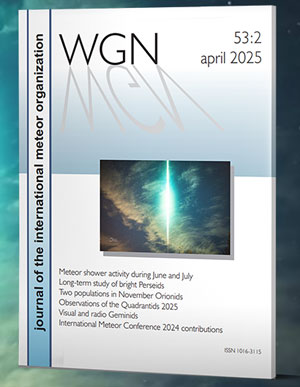During this period the moon reaches its full phase on Wednesday June 15th. At
this time the moon will lie opposite the sun and will be in the sky all night
long. This weekend the waxing gibbous moon will cause problems while above the
horizon. Once it sets during the late morning hours, a small opportunity will
exist for viewing meteor activity between moon set and dawn. The estimated total
hourly rates for evening observers this week is near two as seen from the
northern hemisphere and three as seen from the southern hemisphere. For morning
observers the estimated total hourly rates should be near seven from the
northern hemisphere and seventeen as seen from south of the equator. The actual
rates will also depend on factors such as personal light and motion perception,
local weather conditions, alertness and experience in watching meteor activity.
Evening rates are reduced due to moonlight.
The radiant (the area of the sky where meteors appear
to shoot from) positions and rates listed below are exact for Saturday night/Sunday
morning June 11/12. These positions do not change greatly day to day so the
listed coordinates may be used during this entire period. Most star atlases
(available at science stores and planetariums) will provide maps with grid lines
of the celestial coordinates so that you may find out exactly where these positions
are located in the sky. A planisphere or computer planetarium program is also
useful in showing the sky at any time of night on any date of the year. Activity
from each radiant is best seen when it is positioned highest in the sky, either
due north or south along the meridian, depending on your latitude. It must be
remembered that meteor activity is rarely seen at the radiant position. Rather
they shoot outwards from the radiant so it is best to center your field of view
so that the radiant lies at the edge and not the center. Viewing there will allow
you to easily trace the path of each meteor back to the radiant (if it is a shower
member) or in another direction if it is a sporadic. Meteor activity is not seen
from radiants that are located below the horizon. The positions below are listed
in a west to east manner in order of right ascension (celestial longitude). The
positions listed first are located further west therefore are accessible earlier
in the night while those listed further down the list rise later in the night.
The following showers are expected to be active this week:
The wide Antihelion (ANT) radiant is now centered at 18:16 (274) -23. This area
of the sky lies in northern Sagittarius near the faint star 11 Sagittarii. This
radiant is best placed near 0200 local daylight time (LDT), when it lies on the
meridian and is located highest in the sky. Due to the large size of this
radiant, any meteor radiating from southeastern Ophiuchus, Sagittarius, Scutum,
Serpens Cauda, or eastern Scorpius could be a candidate for this shower. Rates
at this time should be near one per hour as seen from the northern hemisphere
and two per hour as seen from south of the equator. With an entry velocity of 30
km/sec., the average Antihelion meteor would be of medium-slow speed.
As seen from the mid-northern hemisphere (45N) one would expect to see
approximately six sporadic meteors per hour during the last hour before dawn as
seen from rural observing sites. Evening rates would be near one per hour. As
seen from the mid-southern hemisphere (45S), morning rates would be near sixteen
per hour as seen from rural observing sites and two per hour during the evening
hours. Locations between these two extremes would see activity between the
listed figures. Evening rates are reduced due to moonlight.
The table below presents a condensed version of the expected activity this week.
Rates and positions are exact for Saturday night/Sunday morning.
| SHOWER | DATE OF MAXIMUM ACTIVITY | CELESTIAL POSITION | ENTRY VELOCITY | CULMINATION | HOURLY RATE | CLASS* |
| RA (RA in Deg.) DEC | Km/Sec | Local Standard Time | North-South | |||
| Antihelion (ANT) | – | 18:16 (274) -23 | 30 | 0200 | 1 – 2 | II |




 You saw something bright and fast? Like a huge shooting star? Report it: it may be a fireball.
You saw something bright and fast? Like a huge shooting star? Report it: it may be a fireball.  You counted meteors last night? Share your results with us!
You counted meteors last night? Share your results with us!  You took a photo of a meteor or fireball? You have a screenshot of your cam? Share it with us!
You took a photo of a meteor or fireball? You have a screenshot of your cam? Share it with us!  You caught a meteor or fireball on video? Share your video with us!
You caught a meteor or fireball on video? Share your video with us!